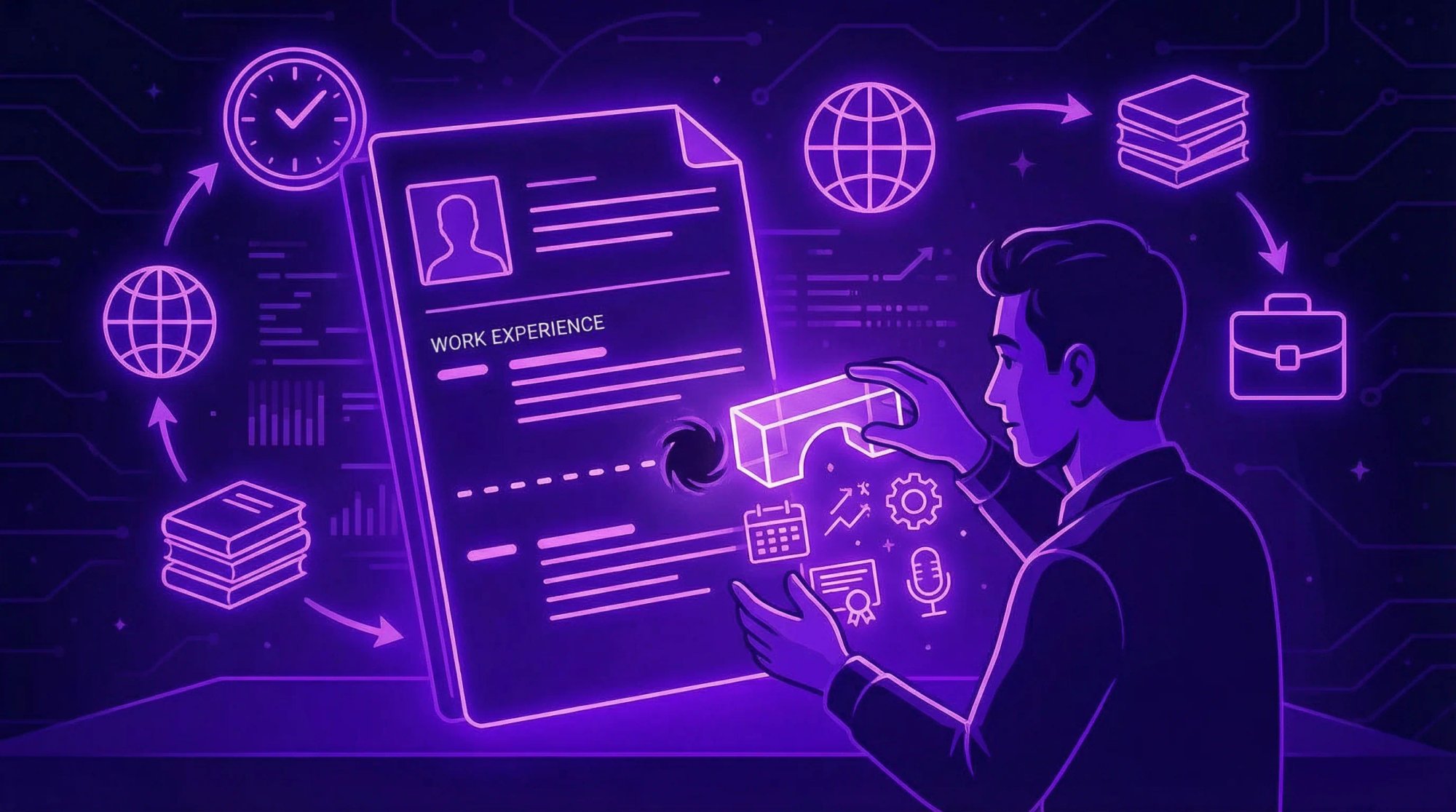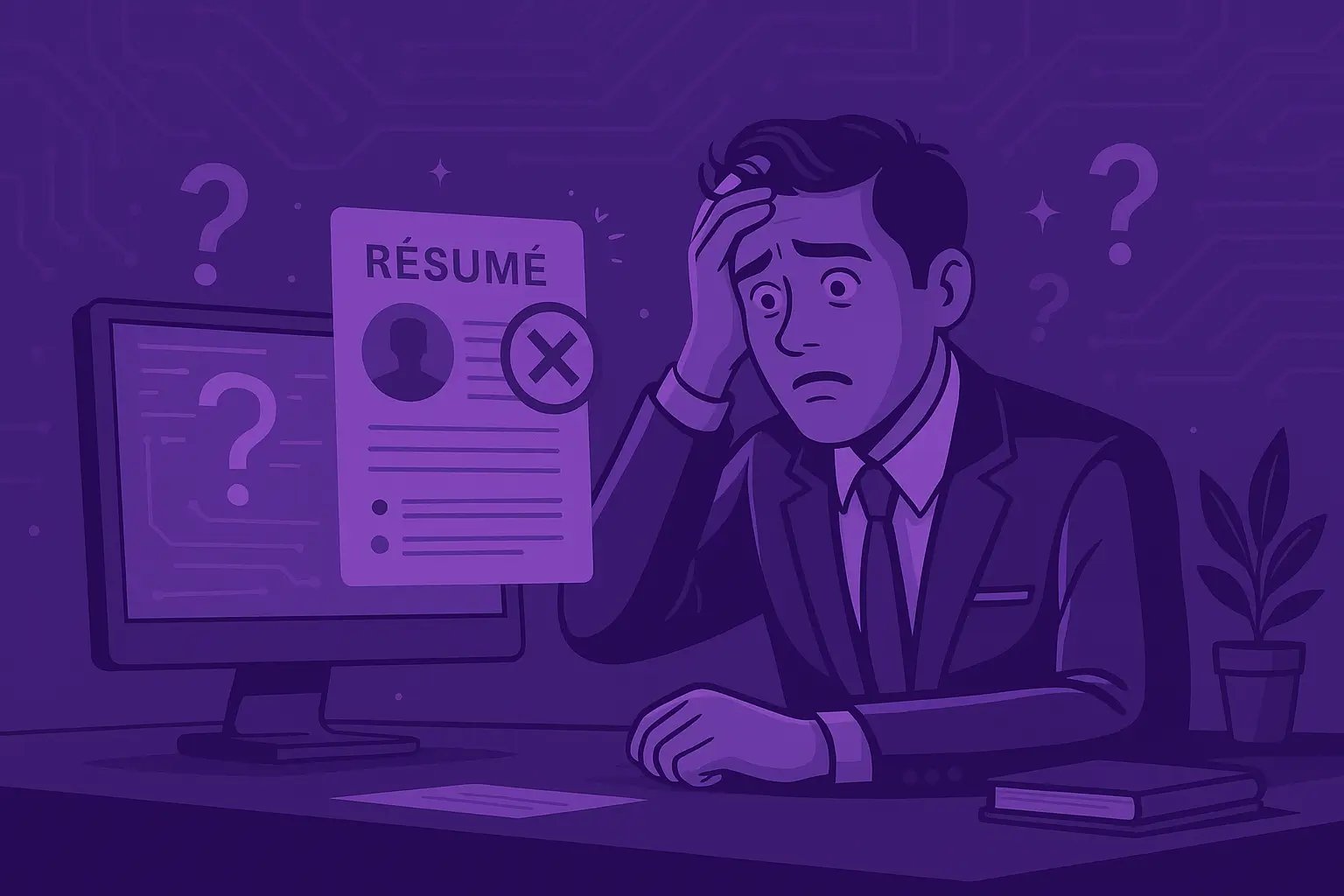Effective Cover Letter for Data Entry Jobs | Tips & Examples

A well-written cover letter for data entry is more than just a formality. It’s your best shot at proving you have the critical skills for the job—like precision and an eagle eye for detail—before you even land an interview. It takes your application from just another resume in the pile and turns it into a compelling argument for why you are the most meticulous, reliable person for the role.
Why a Great Cover Letter Is Your Secret Weapon
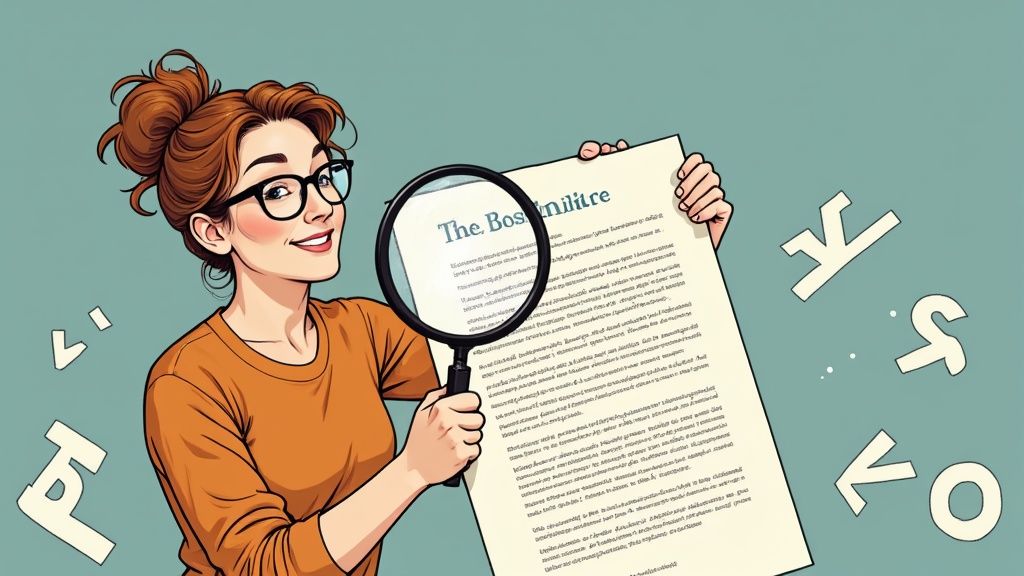
In a field swamped with applicants, it’s easy to think a resume is all you need. But for a job where accuracy is everything, a generic, cookie-cutter application is a huge red flag. A cover letter, tailored specifically for the position, is your first and most powerful tool to show off the very qualities a hiring manager is desperate to find.
Think of it this way: your resume lists your skills, but your cover letter proves them. It’s your chance to connect the dots for the recruiter, showing not just that you have experience, but how that experience will directly benefit their company.
Moving Beyond the Template
The biggest mistake I see people make is just rehashing their resume in paragraph form. Don't do that. Your cover letter should tell a story. This is your platform to:
- Showcase Your Attention to Detail: A letter free of typos and grammatical mistakes, addressed to the right person, is an instant signal of your precision. It's your first test, and you need to pass it.
- Demonstrate Genuine Interest: Mention something specific about the company—a recent project, their mission, anything that shows you’ve done your homework and aren't just blasting out applications.
- Quantify Your Achievements: "Fast and accurate" is just fluff. Instead, say something like, “I consistently processed 400+ invoices daily with a 99.7% accuracy rate.” Numbers speak volumes.
A personalized cover letter is non-negotiable in this field. It’s the first real test of your ability to follow instructions, communicate clearly, and present information accurately—all core functions of a data entry role.
The Proof Is in the Numbers
Don't think for a second that cover letters are obsolete. Far from it. Recent research shows that 64% of hiring managers still consider them a vital part of their decision-making process.
For data entry jobs that get buried in applications, a letter that highlights your typing speed, software skills (like your prowess in Excel or a specific database), and familiarity with their industry is how you stand out. In fact, taking the time to write a tailored cover letter can boost your chances by up to 40%, simply because it shows you actually want this job, not just any job.
Ultimately, skipping the cover letter is a massive missed opportunity. If you're wondering where to start, we've put together a guide on exactly what to include in a cover letter to make sure you hit all the right notes.
Anatomy of a Standout Data Entry Cover Letter
Think of your cover letter not as a block of text, but as a strategic document. Every single part has a job to do. When you understand the purpose behind each section, you can build a letter that actually gets you the interview. This isn’t just about following a template; it’s about making a powerful first impression that sticks.
It all starts with a professional header. Make sure it matches your resume's header perfectly—same font, same layout. Include your full name, phone number, a professional email address, and a link to your LinkedIn profile. This simple consistency shows you’re organized and have an eye for detail right from the top.
Crafting a Compelling Introduction
You have maybe five seconds. That's it. Your opening paragraph is your one shot to hook a busy hiring manager and stop them from hitting "delete." So, ditch the tired old lines like, "I am writing to apply for the Data Entry position."
Instead, lead with genuine enthusiasm and a hard-hitting qualification that speaks directly to what they need.
Try something like this: "When I saw the Data Entry Specialist position at [Company Name] on LinkedIn, I was immediately drawn to it, especially since I've consistently maintained a 99.8% accuracy rate while processing high-volume data in my current role." Right away, you’re specific, confident, and packed with value.
Your introduction has three jobs: state the role you want, show you're genuinely interested in this specific company, and hit them with a quantifiable achievement that makes them think, "Okay, I need to keep reading."
Building the Body with Evidence
This is where you prove you can do the job. Don't just list what you did in past roles—that's what your resume is for. Instead, pick two or three of the most important requirements from the job description and show them you've already mastered them.
Think of it as telling mini-stories with a clear "Problem-Action-Result" flow.
- Showcase Accuracy: Don't just say you're "detail-oriented." Talk about the time you spotted a critical error in a huge dataset, saving the company from a costly mistake. That’s a story they’ll remember.
- Demonstrate Efficiency: Give them the numbers. Mention your typing speed (e.g., 85 WPM) and the sheer volume of work you can handle (e.g., "processed over 500 customer records daily"). Numbers are concrete and persuasive.
- Highlight Technical Skills: Name the tools you’ve mastered. Are you a wizard with advanced Excel functions like VLOOKUPs and Pivot Tables? Have you worked extensively in Salesforce? Explain how you used that software to make a process better or faster.
This section is your chance to go beyond claims and provide real proof of your impact. If you need some ideas on how to frame these stories, looking at a complete example cover letter can show you how it all comes together.
Concluding with Confidence and a Call to Action
Your final paragraph needs to be short, sharp, and forward-looking. Reiterate your excitement for the role and your confidence that you can step in and contribute from day one. Don't just say you're a great fit—quickly remind them why by connecting your top skill directly to their biggest need.
End with a clear, professional call to action. Something like, "I am eager to discuss how my data management skills and commitment to accuracy can be an asset to your team," is proactive without being pushy.
Finally, wrap it up with a professional sign-off like "Sincerely" or "Best regards," followed by your typed name. Simple, clean, and effective.
Showcasing Your Most Valuable Data Entry Skills
Anyone can say they’re “detail-oriented.” Let’s be honest, it’s one of the most overused phrases in the job market, and for a data entry role, it’s just background noise. If you want to grab a hiring manager's attention, you have to do better. You need to show them, not just tell them.
Your cover letter is the perfect place to translate those vague qualities into real, compelling achievements. Instead of listing skills, your goal is to paint a clear picture of how you’ve delivered tangible value. Think in terms of metrics that really matter: accuracy rates, processing volumes, and how you made things more efficient. It’s the difference between saying you’re a fast typist and proving you can clear a backlog.
Beyond Speed: Quantify Your Impact
Imagine you're the hiring manager, sifting through a mountain of applications. You need proof, not promises. The fastest way to provide that proof is with hard numbers that put your skills into a real-world context. Dig into your past experience and pull out some specific metrics.
- Accuracy: How precise are you? Don't just say you're accurate. Frame it with a statistic. For example, "Consistently maintained a 99.8% accuracy rate while verifying thousands of customer account details."
- Volume: Can you handle the workload? Show them. "Efficiently processed an average of 500+ invoices daily, regularly exceeding team targets by 15%."
- Speed: Connect your typing speed to a business outcome. Try something like, "My typing speed of 85 WPM was instrumental in reducing our data backlog during the end-of-quarter rush."
Quantifying your impact like this immediately sets you apart. You’re no longer just a candidate who claims to be good; you're one with a proven track record. For more ideas on framing your accomplishments, check out these professional achievements examples.
From Generic Skills to High-Impact Statements
It’s easy to fall back on generic terms. The table below shows how to transform those tired phrases into powerful statements that showcase your true value.
See the difference? The examples on the right are specific, measurable, and tell a story of competence and impact.
Highlight Your Technical Proficiency
Modern data entry isn't just about hammering keys anymore. The expectations have evolved, and solid technical know-how is non-negotiable. The infographic below drives this point home, highlighting the blend of technical skill and high performance that top employers are looking for.
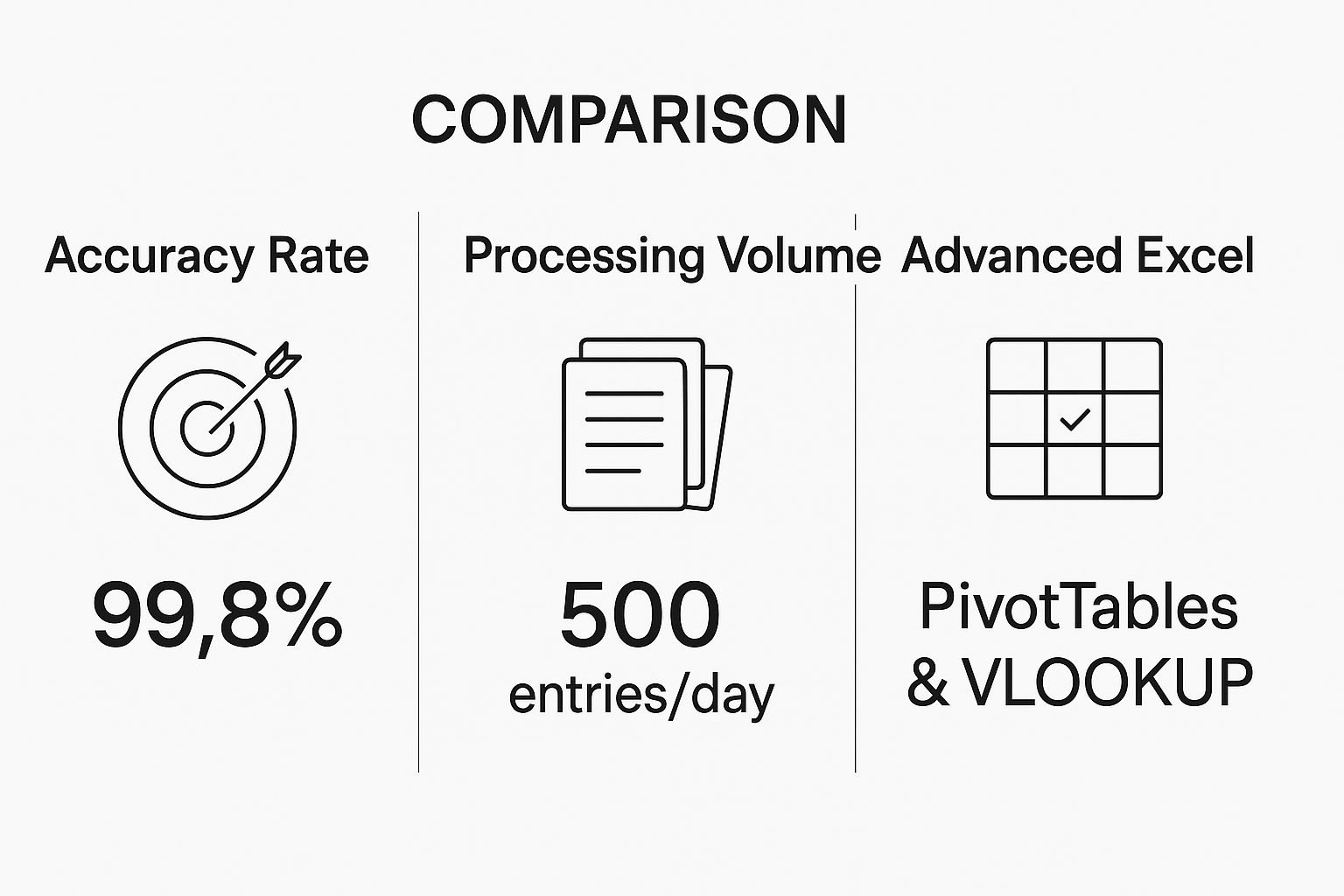
As the graphic shows, the best candidates combine impressive accuracy and volume with advanced software skills, like mastering PivotTables and VLOOKUP in Excel.
The most compelling data entry cover letters don't just state skills; they illustrate them. Showcasing your mastery of specific software or a high accuracy rate gives the hiring manager tangible proof of your value before they even look at your resume.
The demand for these skills is only growing. In fact, roughly 65% of data entry roles now expect some familiarity with CRM platforms and advanced spreadsheet functions. It’s no surprise that applicants who mention specific systems in their cover letters are 28% more likely to land an interview. Staying on top of these trends is key to being competitive.
Frame Soft Skills as Professional Strengths
Finally, let’s talk about those crucial soft skills like confidentiality and organization. Just like your technical abilities, these need to be demonstrated, not just listed.
- For confidentiality, don't just say you're trustworthy. Give an example. "Entrusted with managing confidential employee payroll data, ensuring complete discretion and compliance with privacy protocols."
- For organization, describe a system you improved. "Took the initiative to reorganize our chaotic digital filing system, which cut document retrieval times by 30%."
By backing up every claim with a specific, results-oriented example, you prove you have the complete package of skills needed to excel in any data entry position. You're not just a candidate; you're a problem-solver.
How to Get Past the Applicant Tracking System
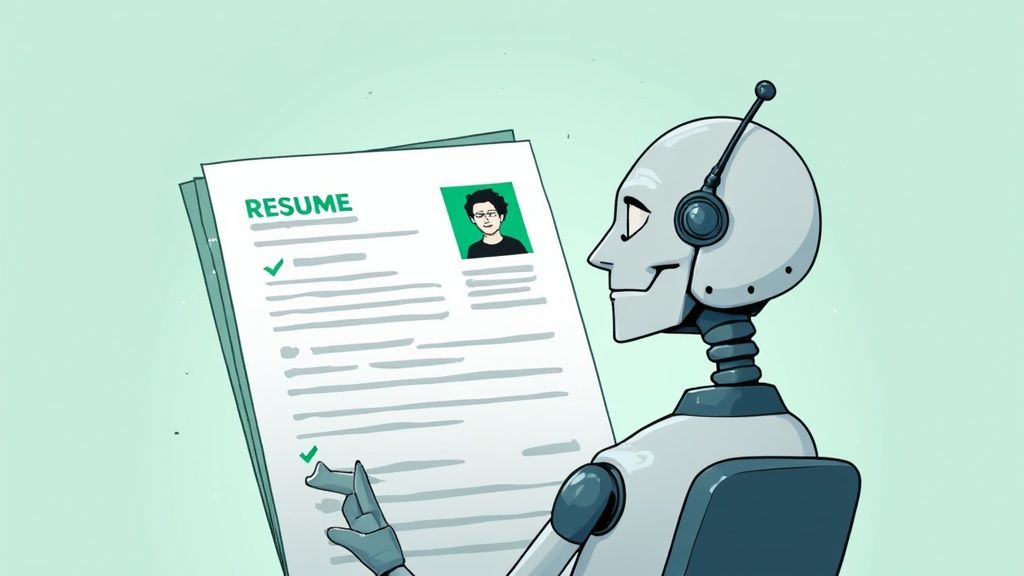
Here’s a hard truth: even the most amazing cover letter means nothing if a hiring manager never lays eyes on it. And these days, it probably won't—at least not at first. Before any human reads your application, it has to get past a digital gatekeeper: the Applicant Tracking System (ATS).
This software is your first hurdle. It scans everything you submit, looking for specific keywords and qualifications to decide if you’re a potential match. Your first mission isn’t to wow a person; it’s to satisfy the robot. For a data entry role, that means your cover letter must be easy for the software to read and packed with the right terms.
Mess this up, and your application gets tossed into a digital void, regardless of how good you are. The real trick is writing something that works for both the software and the human who will hopefully read it next.
Mirror the Language of the Job Description
The single best strategy for getting your cover letter for data entry past an ATS is to speak its language. And where do you find that language? The job description. It's basically an open-book test, and the posting is your answer key.
The software is programmed to hunt for the exact phrases the employer cares about. So, you need to go through that job posting with a fine-tooth comb and lift the keywords directly.
- Mention Specific Software: If the posting lists "Salesforce," "Microsoft Excel," or "Oracle," you need to use those exact names. Don’t just say you have "CRM experience" if they specifically asked for Salesforce.
- Echo Key Skills: Look for terms like "data verification," "database management," "transcription," or "quality assurance." Then, weave those exact phrases into the sentences where you describe what you've done.
- Use Their Metrics: Does the role mention "high-volume data processing" or "maintaining accuracy standards"? Great. Use that language when you highlight your own accomplishments.
An ATS is a matching engine, not an English professor. It doesn't get nuance. If the job requires "data cleansing," your cover letter needs to say "data cleansing," not "tidying up information."
Keep Your Formatting Simple
When you're dealing with an ATS, less is more. All those fancy fonts, columns, headers, or text boxes you might use to stand out can actually trip up the software. The parser might get confused and misread your content—or just skip it entirely.
The goal is a clean, professional layout that the software can digest without any trouble. This is a big reason why about 36% of job seekers use resume or cover letter builders; they’re designed from the ground up to be ATS-compliant. To see this in action, check out some data entry clerk cover letter examples on myperfectresume.com.
Your safest bet is a standard document with clear headings and a universally accepted font like Arial, Calibri, or Times New Roman. It’s not flashy, but it ensures all those carefully selected keywords get read correctly. For more on this, the same principles we outline for ATS-friendly resume templates apply directly to your cover letter.
Common Cover Letter Mistakes That Will Cost You the Job

In a data entry role, precision isn't just a skill—it's the entire job. A tiny mistake in your cover letter can instantly signal to a hiring manager that you lack the one quality they need most. I've seen it happen countless times.
Think of your application as your very first data quality test. If you fail it, you won't get a second chance.
Many candidates sabotage their own chances before the hiring manager even gets to their qualifications. From obvious typos to lazy greetings, these errors are immediate red flags. Let's walk through the most common mistakes I see and why they're so damaging from an employer's point of view.
The Generic and Impersonal Approach
One of the quickest ways to get your application tossed is by sending a generic, one-size-fits-all cover letter. Trust me, hiring managers can spot a template from a mile away. When they see a letter that could be for any company, it just shows a lack of genuine interest and effort.
- Using "To Whom It May Concern": This greeting is an immediate sign you didn't do the bare minimum research to find the hiring manager's name. It feels lazy.
- Forgetting the company name: A letter that doesn’t mention the company you’re applying to screams that you're just firing off applications without any real connection to the role.
- Vague, non-specific language: Phrases like "I am a hardworking professional" are meaningless without context. Show, don't just tell.
A cover letter is your opportunity to show a company why you want to work for them. A generic letter communicates the opposite: that any job will do. This lack of specificity is a major red flag for a role that demands it.
Just Restating Your Resume
Another critical misstep is turning your cover letter into a paragraph version of your resume. Your resume is a factual list of your experiences and skills; your cover letter is where you tell the story behind them. It’s your chance to connect your accomplishments directly to the company's needs.
Instead of just listing duties, explain the impact of your work. How did your accuracy save a previous employer money? How did your efficiency help your team nail a tight deadline? If you find yourself just repeating bullet points, you’re missing the entire point. This is a common problem that leads to both bad resume examples and, by extension, ineffective cover letters.
Focusing on Yourself Instead of Them
It’s tempting to write about what you want from a job, but a great cover letter always focuses on what you can offer the employer. You need to frame your skills and experience from their perspective.
Instead of this: "I am looking for an opportunity to grow my skills in a challenging data entry environment."
Try this: "My experience processing over 500 invoices daily with a 99.8% accuracy rate can help your team manage its high-volume workflow efficiently."
See the difference? The first statement is all about your needs. The second is about solving their problems. Shifting this focus shows you understand their business and are ready to contribute from day one. Avoid these pitfalls, and your cover letter for data entry will stand a much better chance.
Answering Your Toughest Data Entry Cover Letter Questions
Even with the best guide, you're bound to hit a few snags when you sit down to write. It's usually the small details that cause the most headaches. Let's walk through some of the most common questions I hear so you can send off that application feeling completely sure of yourself.
Think of this as your final once-over, clearing up those practical "what if" scenarios. Getting these details right is what shows a hiring manager you’re not just qualified, but also thorough and professional.
How Long Should a Data Entry Cover Letter Be?
Keep it short and sweet. Your target is three to four paragraphs, and it should never, ever spill onto a second page. Remember, the person reading this is likely sifting through a mountain of applications. A letter that gets straight to the point is a huge advantage.
All you need is a quick intro, one or two body paragraphs that show off your biggest wins (with numbers, if you have them!), and a strong, confident closing. The whole point is to make a powerful first impression fast. Your resume is there to fill in the blanks, so don't feel like you need to cram your entire work history in here.
What if I Have No Direct Data Entry Experience?
Don't panic. You've almost certainly got skills that transfer perfectly. The heart of any data entry job is precision, reliability, and attention to detail—and you can prove you have those things through other experiences.
Shift your focus to your transferable skills. Did you do any of these things in past jobs, volunteer roles, or even in school?
- Juggling details? Maybe you managed a complex spreadsheet for a class project or kept track of event RSVPs.
- Keeping things organized? Talk about when you handled inventory records in a retail job or organized files for a small business.
- Using the right tools? Definitely mention your comfort level with software like Microsoft Excel or Google Sheets.
The trick is to connect the dots for the hiring manager. Instead of just saying you're organized, frame it in a way that relates to the job. For example: "While my official title wasn't 'Data Entry Clerk,' I was responsible for accurately maintaining our student organization's membership database of over 200 individuals."
Do I Really Need a Cover Letter if It’s Optional?
Yes. One hundred percent, yes. When an application says a cover letter is "optional," see it as a golden opportunity. A huge chunk of applicants will skip it to save time, so sending one immediately puts you in the top tier.
For a data entry role specifically, submitting a cover letter is your first real chance to prove you’re thorough and proactive. It shows you're willing to go the extra mile, and it gives you a platform to explain why you're a great fit in a way a resume just can't.
Think of an optional cover letter as the ultimate tie-breaker. If two candidates have nearly identical resumes, the one who took the time to write a thoughtful letter almost always gets the interview.
Should I Put My Typing Speed in the Cover Letter?
Absolutely—but only if it’s a strength and especially if the job description mentions a specific Words Per Minute (WPM) requirement. Data entry is a numbers game, so giving them a solid metric right away can be a massive plus.
Don't just drop the number in randomly, though. Weave it into a sentence naturally. Try something like this in your body paragraph: "My typing speed of 80 WPM with 99.5% accuracy allows me to process large volumes of information quickly without ever compromising on quality." This provides hard proof that you have the skills to excel from day one.
Ready to stop writing and start applying? AIApply builds a tailored resume and cover letter for you in minutes, helping you land more interviews without the extra work. Get started for free at aiapply.co.
A well-written cover letter for data entry is more than just a formality. It’s your best shot at proving you have the critical skills for the job—like precision and an eagle eye for detail—before you even land an interview. It takes your application from just another resume in the pile and turns it into a compelling argument for why you are the most meticulous, reliable person for the role.
Why a Great Cover Letter Is Your Secret Weapon

In a field swamped with applicants, it’s easy to think a resume is all you need. But for a job where accuracy is everything, a generic, cookie-cutter application is a huge red flag. A cover letter, tailored specifically for the position, is your first and most powerful tool to show off the very qualities a hiring manager is desperate to find.
Think of it this way: your resume lists your skills, but your cover letter proves them. It’s your chance to connect the dots for the recruiter, showing not just that you have experience, but how that experience will directly benefit their company.
Moving Beyond the Template
The biggest mistake I see people make is just rehashing their resume in paragraph form. Don't do that. Your cover letter should tell a story. This is your platform to:
- Showcase Your Attention to Detail: A letter free of typos and grammatical mistakes, addressed to the right person, is an instant signal of your precision. It's your first test, and you need to pass it.
- Demonstrate Genuine Interest: Mention something specific about the company—a recent project, their mission, anything that shows you’ve done your homework and aren't just blasting out applications.
- Quantify Your Achievements: "Fast and accurate" is just fluff. Instead, say something like, “I consistently processed 400+ invoices daily with a 99.7% accuracy rate.” Numbers speak volumes.
A personalized cover letter is non-negotiable in this field. It’s the first real test of your ability to follow instructions, communicate clearly, and present information accurately—all core functions of a data entry role.
The Proof Is in the Numbers
Don't think for a second that cover letters are obsolete. Far from it. Recent research shows that 64% of hiring managers still consider them a vital part of their decision-making process.
For data entry jobs that get buried in applications, a letter that highlights your typing speed, software skills (like your prowess in Excel or a specific database), and familiarity with their industry is how you stand out. In fact, taking the time to write a tailored cover letter can boost your chances by up to 40%, simply because it shows you actually want this job, not just any job.
Ultimately, skipping the cover letter is a massive missed opportunity. If you're wondering where to start, we've put together a guide on exactly what to include in a cover letter to make sure you hit all the right notes.
Anatomy of a Standout Data Entry Cover Letter
Think of your cover letter not as a block of text, but as a strategic document. Every single part has a job to do. When you understand the purpose behind each section, you can build a letter that actually gets you the interview. This isn’t just about following a template; it’s about making a powerful first impression that sticks.
It all starts with a professional header. Make sure it matches your resume's header perfectly—same font, same layout. Include your full name, phone number, a professional email address, and a link to your LinkedIn profile. This simple consistency shows you’re organized and have an eye for detail right from the top.
Crafting a Compelling Introduction
You have maybe five seconds. That's it. Your opening paragraph is your one shot to hook a busy hiring manager and stop them from hitting "delete." So, ditch the tired old lines like, "I am writing to apply for the Data Entry position."
Instead, lead with genuine enthusiasm and a hard-hitting qualification that speaks directly to what they need.
Try something like this: "When I saw the Data Entry Specialist position at [Company Name] on LinkedIn, I was immediately drawn to it, especially since I've consistently maintained a 99.8% accuracy rate while processing high-volume data in my current role." Right away, you’re specific, confident, and packed with value.
Your introduction has three jobs: state the role you want, show you're genuinely interested in this specific company, and hit them with a quantifiable achievement that makes them think, "Okay, I need to keep reading."
Building the Body with Evidence
This is where you prove you can do the job. Don't just list what you did in past roles—that's what your resume is for. Instead, pick two or three of the most important requirements from the job description and show them you've already mastered them.
Think of it as telling mini-stories with a clear "Problem-Action-Result" flow.
- Showcase Accuracy: Don't just say you're "detail-oriented." Talk about the time you spotted a critical error in a huge dataset, saving the company from a costly mistake. That’s a story they’ll remember.
- Demonstrate Efficiency: Give them the numbers. Mention your typing speed (e.g., 85 WPM) and the sheer volume of work you can handle (e.g., "processed over 500 customer records daily"). Numbers are concrete and persuasive.
- Highlight Technical Skills: Name the tools you’ve mastered. Are you a wizard with advanced Excel functions like VLOOKUPs and Pivot Tables? Have you worked extensively in Salesforce? Explain how you used that software to make a process better or faster.
This section is your chance to go beyond claims and provide real proof of your impact. If you need some ideas on how to frame these stories, looking at a complete example cover letter can show you how it all comes together.
Concluding with Confidence and a Call to Action
Your final paragraph needs to be short, sharp, and forward-looking. Reiterate your excitement for the role and your confidence that you can step in and contribute from day one. Don't just say you're a great fit—quickly remind them why by connecting your top skill directly to their biggest need.
End with a clear, professional call to action. Something like, "I am eager to discuss how my data management skills and commitment to accuracy can be an asset to your team," is proactive without being pushy.
Finally, wrap it up with a professional sign-off like "Sincerely" or "Best regards," followed by your typed name. Simple, clean, and effective.
Showcasing Your Most Valuable Data Entry Skills
Anyone can say they’re “detail-oriented.” Let’s be honest, it’s one of the most overused phrases in the job market, and for a data entry role, it’s just background noise. If you want to grab a hiring manager's attention, you have to do better. You need to show them, not just tell them.
Your cover letter is the perfect place to translate those vague qualities into real, compelling achievements. Instead of listing skills, your goal is to paint a clear picture of how you’ve delivered tangible value. Think in terms of metrics that really matter: accuracy rates, processing volumes, and how you made things more efficient. It’s the difference between saying you’re a fast typist and proving you can clear a backlog.
Beyond Speed: Quantify Your Impact
Imagine you're the hiring manager, sifting through a mountain of applications. You need proof, not promises. The fastest way to provide that proof is with hard numbers that put your skills into a real-world context. Dig into your past experience and pull out some specific metrics.
- Accuracy: How precise are you? Don't just say you're accurate. Frame it with a statistic. For example, "Consistently maintained a 99.8% accuracy rate while verifying thousands of customer account details."
- Volume: Can you handle the workload? Show them. "Efficiently processed an average of 500+ invoices daily, regularly exceeding team targets by 15%."
- Speed: Connect your typing speed to a business outcome. Try something like, "My typing speed of 85 WPM was instrumental in reducing our data backlog during the end-of-quarter rush."
Quantifying your impact like this immediately sets you apart. You’re no longer just a candidate who claims to be good; you're one with a proven track record. For more ideas on framing your accomplishments, check out these professional achievements examples.
From Generic Skills to High-Impact Statements
It’s easy to fall back on generic terms. The table below shows how to transform those tired phrases into powerful statements that showcase your true value.
See the difference? The examples on the right are specific, measurable, and tell a story of competence and impact.
Highlight Your Technical Proficiency
Modern data entry isn't just about hammering keys anymore. The expectations have evolved, and solid technical know-how is non-negotiable. The infographic below drives this point home, highlighting the blend of technical skill and high performance that top employers are looking for.

As the graphic shows, the best candidates combine impressive accuracy and volume with advanced software skills, like mastering PivotTables and VLOOKUP in Excel.
The most compelling data entry cover letters don't just state skills; they illustrate them. Showcasing your mastery of specific software or a high accuracy rate gives the hiring manager tangible proof of your value before they even look at your resume.
The demand for these skills is only growing. In fact, roughly 65% of data entry roles now expect some familiarity with CRM platforms and advanced spreadsheet functions. It’s no surprise that applicants who mention specific systems in their cover letters are 28% more likely to land an interview. Staying on top of these trends is key to being competitive.
Frame Soft Skills as Professional Strengths
Finally, let’s talk about those crucial soft skills like confidentiality and organization. Just like your technical abilities, these need to be demonstrated, not just listed.
- For confidentiality, don't just say you're trustworthy. Give an example. "Entrusted with managing confidential employee payroll data, ensuring complete discretion and compliance with privacy protocols."
- For organization, describe a system you improved. "Took the initiative to reorganize our chaotic digital filing system, which cut document retrieval times by 30%."
By backing up every claim with a specific, results-oriented example, you prove you have the complete package of skills needed to excel in any data entry position. You're not just a candidate; you're a problem-solver.
How to Get Past the Applicant Tracking System

Here’s a hard truth: even the most amazing cover letter means nothing if a hiring manager never lays eyes on it. And these days, it probably won't—at least not at first. Before any human reads your application, it has to get past a digital gatekeeper: the Applicant Tracking System (ATS).
This software is your first hurdle. It scans everything you submit, looking for specific keywords and qualifications to decide if you’re a potential match. Your first mission isn’t to wow a person; it’s to satisfy the robot. For a data entry role, that means your cover letter must be easy for the software to read and packed with the right terms.
Mess this up, and your application gets tossed into a digital void, regardless of how good you are. The real trick is writing something that works for both the software and the human who will hopefully read it next.
Mirror the Language of the Job Description
The single best strategy for getting your cover letter for data entry past an ATS is to speak its language. And where do you find that language? The job description. It's basically an open-book test, and the posting is your answer key.
The software is programmed to hunt for the exact phrases the employer cares about. So, you need to go through that job posting with a fine-tooth comb and lift the keywords directly.
- Mention Specific Software: If the posting lists "Salesforce," "Microsoft Excel," or "Oracle," you need to use those exact names. Don’t just say you have "CRM experience" if they specifically asked for Salesforce.
- Echo Key Skills: Look for terms like "data verification," "database management," "transcription," or "quality assurance." Then, weave those exact phrases into the sentences where you describe what you've done.
- Use Their Metrics: Does the role mention "high-volume data processing" or "maintaining accuracy standards"? Great. Use that language when you highlight your own accomplishments.
An ATS is a matching engine, not an English professor. It doesn't get nuance. If the job requires "data cleansing," your cover letter needs to say "data cleansing," not "tidying up information."
Keep Your Formatting Simple
When you're dealing with an ATS, less is more. All those fancy fonts, columns, headers, or text boxes you might use to stand out can actually trip up the software. The parser might get confused and misread your content—or just skip it entirely.
The goal is a clean, professional layout that the software can digest without any trouble. This is a big reason why about 36% of job seekers use resume or cover letter builders; they’re designed from the ground up to be ATS-compliant. To see this in action, check out some data entry clerk cover letter examples on myperfectresume.com.
Your safest bet is a standard document with clear headings and a universally accepted font like Arial, Calibri, or Times New Roman. It’s not flashy, but it ensures all those carefully selected keywords get read correctly. For more on this, the same principles we outline for ATS-friendly resume templates apply directly to your cover letter.
Common Cover Letter Mistakes That Will Cost You the Job

In a data entry role, precision isn't just a skill—it's the entire job. A tiny mistake in your cover letter can instantly signal to a hiring manager that you lack the one quality they need most. I've seen it happen countless times.
Think of your application as your very first data quality test. If you fail it, you won't get a second chance.
Many candidates sabotage their own chances before the hiring manager even gets to their qualifications. From obvious typos to lazy greetings, these errors are immediate red flags. Let's walk through the most common mistakes I see and why they're so damaging from an employer's point of view.
The Generic and Impersonal Approach
One of the quickest ways to get your application tossed is by sending a generic, one-size-fits-all cover letter. Trust me, hiring managers can spot a template from a mile away. When they see a letter that could be for any company, it just shows a lack of genuine interest and effort.
- Using "To Whom It May Concern": This greeting is an immediate sign you didn't do the bare minimum research to find the hiring manager's name. It feels lazy.
- Forgetting the company name: A letter that doesn’t mention the company you’re applying to screams that you're just firing off applications without any real connection to the role.
- Vague, non-specific language: Phrases like "I am a hardworking professional" are meaningless without context. Show, don't just tell.
A cover letter is your opportunity to show a company why you want to work for them. A generic letter communicates the opposite: that any job will do. This lack of specificity is a major red flag for a role that demands it.
Just Restating Your Resume
Another critical misstep is turning your cover letter into a paragraph version of your resume. Your resume is a factual list of your experiences and skills; your cover letter is where you tell the story behind them. It’s your chance to connect your accomplishments directly to the company's needs.
Instead of just listing duties, explain the impact of your work. How did your accuracy save a previous employer money? How did your efficiency help your team nail a tight deadline? If you find yourself just repeating bullet points, you’re missing the entire point. This is a common problem that leads to both bad resume examples and, by extension, ineffective cover letters.
Focusing on Yourself Instead of Them
It’s tempting to write about what you want from a job, but a great cover letter always focuses on what you can offer the employer. You need to frame your skills and experience from their perspective.
Instead of this: "I am looking for an opportunity to grow my skills in a challenging data entry environment."
Try this: "My experience processing over 500 invoices daily with a 99.8% accuracy rate can help your team manage its high-volume workflow efficiently."
See the difference? The first statement is all about your needs. The second is about solving their problems. Shifting this focus shows you understand their business and are ready to contribute from day one. Avoid these pitfalls, and your cover letter for data entry will stand a much better chance.
Answering Your Toughest Data Entry Cover Letter Questions
Even with the best guide, you're bound to hit a few snags when you sit down to write. It's usually the small details that cause the most headaches. Let's walk through some of the most common questions I hear so you can send off that application feeling completely sure of yourself.
Think of this as your final once-over, clearing up those practical "what if" scenarios. Getting these details right is what shows a hiring manager you’re not just qualified, but also thorough and professional.
How Long Should a Data Entry Cover Letter Be?
Keep it short and sweet. Your target is three to four paragraphs, and it should never, ever spill onto a second page. Remember, the person reading this is likely sifting through a mountain of applications. A letter that gets straight to the point is a huge advantage.
All you need is a quick intro, one or two body paragraphs that show off your biggest wins (with numbers, if you have them!), and a strong, confident closing. The whole point is to make a powerful first impression fast. Your resume is there to fill in the blanks, so don't feel like you need to cram your entire work history in here.
What if I Have No Direct Data Entry Experience?
Don't panic. You've almost certainly got skills that transfer perfectly. The heart of any data entry job is precision, reliability, and attention to detail—and you can prove you have those things through other experiences.
Shift your focus to your transferable skills. Did you do any of these things in past jobs, volunteer roles, or even in school?
- Juggling details? Maybe you managed a complex spreadsheet for a class project or kept track of event RSVPs.
- Keeping things organized? Talk about when you handled inventory records in a retail job or organized files for a small business.
- Using the right tools? Definitely mention your comfort level with software like Microsoft Excel or Google Sheets.
The trick is to connect the dots for the hiring manager. Instead of just saying you're organized, frame it in a way that relates to the job. For example: "While my official title wasn't 'Data Entry Clerk,' I was responsible for accurately maintaining our student organization's membership database of over 200 individuals."
Do I Really Need a Cover Letter if It’s Optional?
Yes. One hundred percent, yes. When an application says a cover letter is "optional," see it as a golden opportunity. A huge chunk of applicants will skip it to save time, so sending one immediately puts you in the top tier.
For a data entry role specifically, submitting a cover letter is your first real chance to prove you’re thorough and proactive. It shows you're willing to go the extra mile, and it gives you a platform to explain why you're a great fit in a way a resume just can't.
Think of an optional cover letter as the ultimate tie-breaker. If two candidates have nearly identical resumes, the one who took the time to write a thoughtful letter almost always gets the interview.
Should I Put My Typing Speed in the Cover Letter?
Absolutely—but only if it’s a strength and especially if the job description mentions a specific Words Per Minute (WPM) requirement. Data entry is a numbers game, so giving them a solid metric right away can be a massive plus.
Don't just drop the number in randomly, though. Weave it into a sentence naturally. Try something like this in your body paragraph: "My typing speed of 80 WPM with 99.5% accuracy allows me to process large volumes of information quickly without ever compromising on quality." This provides hard proof that you have the skills to excel from day one.
Ready to stop writing and start applying? AIApply builds a tailored resume and cover letter for you in minutes, helping you land more interviews without the extra work. Get started for free at aiapply.co.
Don't miss out on
your next opportunity.
Create and send applications in seconds, not hours.






